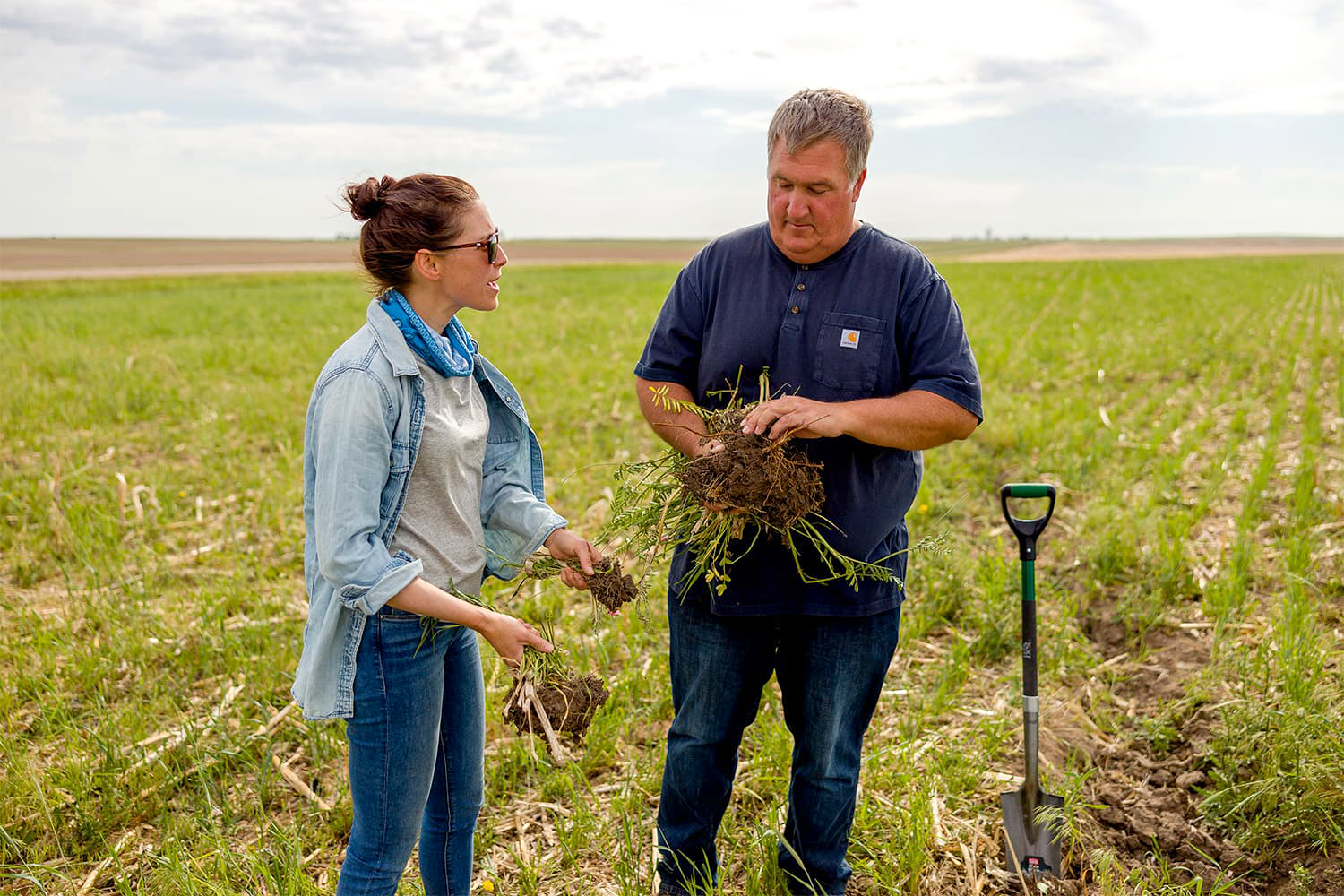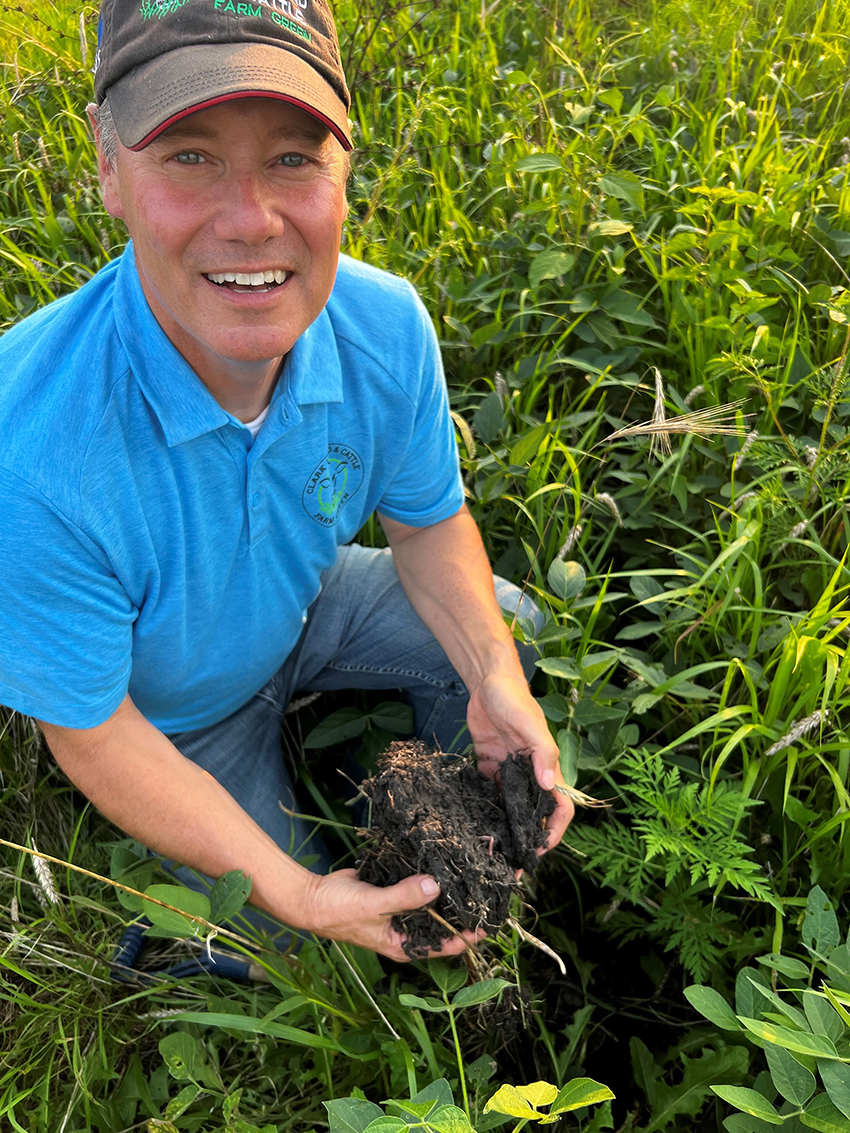They don’t need GMO traits and can build soil health, reduce inputs, increase biodiversity, and earn premium markets growing non-GMO
Genetically modified corn and soybeans dominate U.S. agriculture with more than 90% of those crops planted with GMO varieties. But a growing number of farmers who use regenerative agriculture practices—such as no-till, cover crops, and diverse crop rotations—are abandoning GMO seed varieties in favor of non-GMO seeds.
Rick Clark, a regenerative farmer in Warren County, Indiana, says he “unfortunately” grew GMO corn and soybeans for 10 years.
“At the time, there was a big trend for GMO because we had chemistry to spray on cash crops and not kill them and kill the weeds,” he says.
But over time he had misgivings about growing GMOs. “I realized that as we were on this journey of being regenerative, we had to make the switch to non-GMO,” Clark says.
Seeing more farmers growing non-GMO
Clark’s experience is increasingly common, says John Kempf, founder of Advancing Eco Agriculture, a company that works with farmers to develop large-scale regenerative farming systems.
“We are seeing more farmers growing non-traited (non-GMO),” Kempf says. “The benefits they thought they were getting (from GMO seeds) were not true.”
One of the most influential regenerative farmers, Gabe Brown, doesn’t plant GMO seeds, and others are having similar experiences as they adopt regenerative practices.
Steve Tucker, a regenerative farmer in Venango, Nebraska, says he grew GMO corn for several years but now says he doesn’t need it.
“We are so diverse with cover crops, there’s no need for that (GMO) stuff.”
Ted Hinton, who farms in Hiawatha, Kansas, had a similar experience. “I don’t need the (GMO) traits. Cover crops have done things I would never have expected. GMOs are an over-used tool.”
Kempf says it makes sense that farmers wouldn’t need to plant GMO crops.
“As they improve soil health, corn becomes more resistant to insects, and (GMO) traits become less relevant,” he says.
Lower non-GMO seed cost, better yields

“We are so diverse with cover crops, there’s no need for that (GMO) stuff.”—regenerative farmer Steve Tucker shown with Kristy Lewis, chief visionary officer at Quinn Snacks
Kempf cites other reasons why farmers are going non-GMO. The cost for GMO corn and soybean seeds can be twice as much as for non-GMO. Another reason is that non-GMO corn hybrids yield as good as or even better than GMO seed varieties.
“Many growers have observed as they go through the transition and make efforts to improve soil health that more traditional (non-GMO) hybrids perform better than GMO counterparts,” Kempf says.
This has been shown in field trials comparing the performance of GMO and non-GMO seed. Companies that sell non-GMO seed such as Albert Lea Seed, Prairie Hybrids, and Spectrum Non-GMO have shown that their seed varieties produce perform better GMO varieties.
Monte Bottens, a regenerative farmer in Cambridge, Illinois switched from growing GMO to non-GMO corn and found that his non-GMO corn produces as good as GMO corn. “Non-GMO corn is easy to work with; it’s better,” he says.
Negative impacts on soil health
Then there are possible negative impacts of GMO crops on soil health. GMO corn will have a different microbiome than non-GMO, according to Kempf.
“There is the possibility that the microbiomes associated with GMO crops can lead to a much more disease susceptible crop,” he says. By contrast, Kempf says the microbiome associated with a non-GMO crop tends to suppress disease.
Then there is the negative impact of glyphosate herbicide, which is used extensively with herbicide-tolerant GMO crops.
“Glyphosate is among the more harmful herbicides in terms of damaging the soil microbiome,” Kempf says.
Farmers who grow GMO corn for an extended period will have more disease pressure. “Fungicide applications (on corn) were unheard of 10 years ago,” Kempf says. “Now they are commonplace.”
A 2011 study published in the American Journal of Botany found that GMO Bt corn affects the symbiotic relationship with beneficial arbuscular mycorrhizal fungi, the soil microbes that establish a connection between the plant and soil, increase nutrient availability, and inhibit root pathogens. GMO corn was found to have reduced colonization of arbuscular mycorrhizal fungi in plant roots compared to non-GMO corn.
Increased biodiversity, reduced chemical inputs
In addition to improved soil health, Bottens has seen increased biodiversity in his fields since planting non-GMO crops. He attributes this to using non-GMO seed that is not coated with toxic neonicotinoid pesticides, which are used to coat GMO seed.
“I haven’t used neonics for five years and have seen improvements with more wildlife, birds and insects,” Bottens says.
Cameron Mills, a regenerative farmer in Walton, Indiana, has seen similar benefits growing non-GMO. “We have more beneficial insects offsetting the pests.”
Bottens is also concerned about health risks of GMO crops, specifically that GMO traits could be passed to people. “I’m concerned about gene transfer from plants to animals and people. I didn’t want to be Roundup Ready and don’t think people should be also.”
Like Bottens, other regenerative farmers say they have reduced their use of synthetic inputs such as pesticides since switching to non-GMO crops and regenerative practices. Clark eliminated all synthetic inputs and has transitioned to organic. Mills doesn’t use fungicides or insecticides.
“I haven’t used a commercial fungicide or insecticide in four years,” Hinton says.
Graham Christensen, who grows non-GMO corn and soybeans on his 800-acre regenerative farm in Lyons, Nebraska, stopped using glyphosate herbicide.
“We don’t need glyphosate corn; we just don’t,” he says.
Non-GMO markets
Regenerative farmers also cite the premium prices they earn for selling their non-GMO corn and soybeans. Rick Clark sold his non-GMO corn to Dannon for their non-GMO verified yogurt products. Mills found non-GMO premium opportunities selling to ADM and Cargill. He also grows open pollinated non-GMO corn varieties, mills them into flour, and sells the flour. Hinton sells his non-GMO corn to Lifeline Foods, a non-GMO corn miller in St. Joseph, Missouri. Bottens sells his non-GMO corn to Prairie Choice, a non-GMO corn miller and Consolidated Grain and Barge for export.
“The economics work. I’m willing to manage and work a little more,” Bottens says.
Beyond the economic advantages, several regenerative farmers say growing non-GMO corn just feels more natural to them.
“GMO was created because we try to play God and monocrop,” Tucker says. “We work with nature instead of playing God.”
“I just feel like if you are going to be regenerative and working with nature and reducing inputs, then you have to be non-GMO as well,” Clark says.
Looking at the big picture, Clark says: “Building soil and human health, being a good steward to the land, and being conservation minded. That’s why we do what we do here.”









